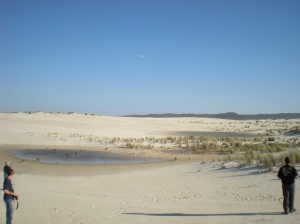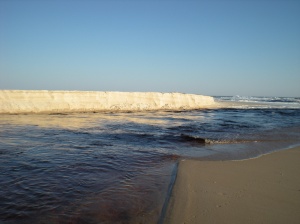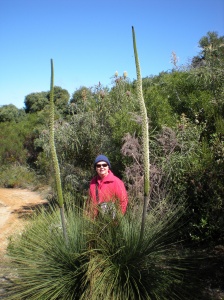We arrived in Margaret River a couple of days ago and it was cold and rainy and we were a bit underwhelmed, although we cheered up after lunch and a glass of red in a nice, warm tavern. I expected it to be more picturesque and it is just a town, and less attractive than many we have seen. However, the surrounding countryside, the wineries and the beaches are all beautiful and we had a lovely day yesterday exploring and looking for wildflowers. The unfortunate payoff to this was the tick which Geoff noticed on my back this morning. First Geoff applied metho and then eucalyptus oil but the little blighter just thought he’d landed in a health spa and continued to hang on. Tweezers were needed to see him off. Then I found another tick on my leg which Geoff lassoed with a piece of dental floss – a prescribed method of removal, believe it or not. Victorian suburbanites don’t generally have to worry about ticks so it was all a bit of a shock. Now I view the forest with a jaundiced eye – not as a treasure house of wildflowers but a jungle bristling with nasty, little bloodsuckers. I thought I only had to worry about snakes which you can at least see.
Today we visited the Cape Leeuwin lighthouse on the extreme south West Point of Australia. Cape Leeuwin was named by Matthew Flinders in December 1801 at the commencement of the circumnavigation of Terra Australis, taking the name of the adjoining area which had been
- Cape Leeuwin Lighthouse
- Cape Leeuwin
- Pink Rainbow
- Rose Banjine
- Milkmaids
- Red and Green Kangaroo Paw
- Cowslip Orchids
- Yellow Flags
- Yellow Flag
- Geraldton Wax
- Pink Boronia at Vasse Felix winery
called Leeuwin’s Land by the Dutch navigators when Leeuwin (The Lioness) rounded the Cape in 1622. The lighthouse was opened in 1896 and is still one of the essential navigation aids maintained around the Australian coast. It was automated in 1992. It was cold, wet and windy at Cape Leeuwin today – mild in comparison to the weather that can occur here, at the meeting of the Southern and Indian Oceans. It would have been a tough life for the lighthouse keepers and their families, especially since they had an outside loo which would have been quite challenging to get to during a gale.








































































































































